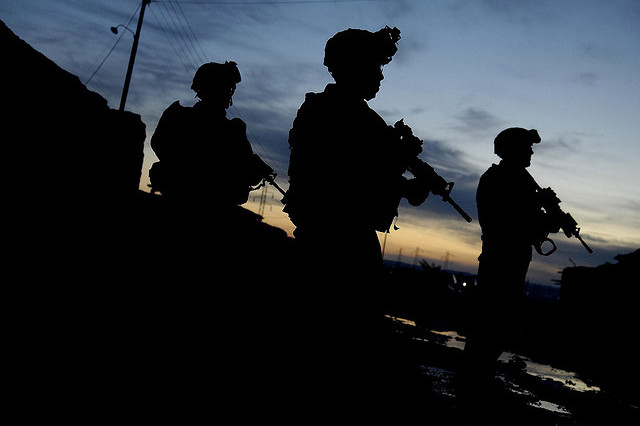by John Feffer
The targeted assassination of Taliban leader Mullah Akhtar Mohammad Mansour last weekend wasn’t just another drone strike.
First of all, it was conducted by the U.S. military, not the CIA, which has orchestrated nearly all drone strikes in Pakistan.
Second, it didn’t take place in Afghanistan or in the so-called lawless tribal region of Pakistan known as the Federally Administered Tribal Areas, or FATA. The guided missile turned a white Toyota and its two passengers into a fireball on a well-traveled highway in Balochistan, in southwest Pakistan.
Prior to this particular drone strike, Pakistan allowed the United States to patrol the skies over the northwest region of FATA, a Taliban stronghold. But President Obama decided to cross this “red line” to take out Mansour (and a taxi driver, Muhammad Azam, who had the misfortune to be with the wrong passenger at the wrong time).
Pakistani leaders have registered their disapproval. According to former ambassador to the United States Sherry Rehman, “The drone strike is different from all others because it has not only resumed a genre of kinetic action that is unilateral, but also illegal and expansionary in its geographical theater of targeted operation.”
In other words, if the United States is sending drones after targets in Balochistan, what will prevent it from taking out a suspected terrorist on the crowded streets of Karachi or Islamabad?
The Obama administration is congratulating itself on removing a bad guy who was targeting U.S. military personnel in Afghanistan. But the strike itself may not produce any greater willingness on the part of the Taliban to enter into negotiations with the Afghan government. Mansour, according to the administration, opposed such negotiations, and the Taliban has indeed refused to join talks in Pakistan with the Quadrilateral Coordination Group — Pakistan, Afghanistan, China, the United States — unless foreign troops are first removed from Afghanistan.
This “kill for peace” strategy of the Obama administration may backfire.
According to senior Taliban leaders, Mansour’s death will help the fractious organization unify around a new leader. Conversely, despite such rosy insider predictions, the Taliban could splinter and enable even more extremist organizations like al-Qaeda and the Islamic State to fill the void. In a third scenario, the drone strike will have no impact on the ground in Afghanistan at all, since the current fighting season is already underway and the Taliban want to strengthen their bargaining position before entering talks.
In other words, the United States cannot possibly know whether Mansour’s death will advance or complicate U.S. strategic goals in the region. The drone strike is, basically, a crapshoot.
The strike also comes at a time when U.S. drone policy is coming under greater scrutiny within the United States. After a number of independent assessments of drone casualties, the Obama administration will soon release its own estimate of the death toll for combatants and non-combatants outside of active war zones. A new independent assessment of drone strikes in FATA argues that the long-anticipated “blowback” has not in fact taken place. And the Obama administration is desperately trying to salvage a policy in Afghanistan that’s failed to draw down U.S. troop levels as promised, fully turn over the responsibility for military operations to the Afghan government, or stop the Taliban from making significant battlefield gains.
Mansour’s death is the latest example of the United States dispensing death at a distance in an attempt to micromanage a conflict that it’s long since lost control over. The precision of the strikes belies the imprecision of U.S. policy and the virtual impossibility of achieving U.S. goals as currently stated.
The Question of Blowback
The term “blowback” was originally a CIA term for the unintended — and negative — consequences of clandestine operations. One of the most famous examples was the U.S. funneling of arms and supplies to the mujahedeen fighting the Soviets in Afghanistan. Some of these fighters, including Osama bin Laden, would eventually turn their weapons against U.S. targets once the Soviets were long gone from the country.
The U.S. drone campaign isn’t exactly a covert operation, though the CIA has generally refused to acknowledge its role in the attacks (the Pentagon is more open about its use of drones for strikes on more conventional military targets). But critics of drone attacks — myself included — have long argued that all the civilian casualties caused by drone attacks will produce blowback. Drone strikes and the anger they generate effectively serve to recruit people into the Taliban and other extremist organizations.
Even those involved in the program have come to the same conclusion.
Consider, for instance, this impassioned plea to President Obama from four Air Force veterans who piloted drones. “The innocent civilians we were killing only fueled the feelings of hatred that ignited terrorism and groups like ISIS, while also serving as a fundamental recruitment tool,” they argued in a letter last November. “The administration and its predecessors have built a drone program that is one of the most devastating driving forces for terrorism and destabilization around the world.”
But now along comes Aqil Shah, a professor at the University of Oklahoma, who has justpublished a report attempting to debunk this claim.
According to a set of 147 interviews he conducted in North Waziristan, an area in Pakistan’s FATA that has sustained the largest number of drone strikes, 79 percent of respondents support the campaign. A majority believes that the strikes rarely kill non-combatants. Further, according to experts cited by Shah, “most locals prefer drones to the Pakistan military’s ground and aerial offensives that cause more extensive damage to civilian life and property.”
I don’t doubt these findings. Most people in Pakistan have no sympathy for the Taliban. According to a recent Pew poll, 72 percent of respondents in Pakistan had an unfavorable view of the Taliban (with earlier polls suggesting that this lack of support extends to FATA). Drones are no doubt better than Pakistan’s military operations, just as they represent an improvement over the scorched-earth policies used by the United States in the Vietnam War to destroy large sections of Southeast Asia.
Shah’s research was not exactly scientific. He admits that his interviews were “not statistically representative” — and then goes on to draw conclusions about the entire population of FATA. It’s also true that several other polls suggest that Pakistanis throughout the country oppose the drone program and believe that it encourages militancy, but these polls have generally not included FATA.
But Shah’s most controversial conclusion is that the high level of support for the drone program means that no blowback has taken place. Even if his interviews were statistically representative, I don’t understand this analytical leap.
Blowback doesn’t require universal opposition. Only a small percentage of the mujahedeen went on to fight with Osama bin Laden. Only a certain number of Contras were involved in operations that pumped drugs into the United States.
It’s not as if the entire population of FATA is going to join the Taliban. If only a couple thousand young men join the Taliban out of anger over drone strikes, that counts as blowback. There are over 4 million people living in the FATA. A fighting force of 4,000 people is one-tenth of one percent of the population — and that easily falls within the 21 percent of respondents who disapproved of drones in Shah’s findings.
And what of the suicide bomber who embarks on his path of extremism because a drone strike took out his brother? The Times Square bomber, Faisal Shahzad, was motivated at least in part by drone strikes in Pakistan, even though they hadn’t killed anyone in his family.
Ultimately, blowback can be just one angry and determined person who makes his mark on history without first showing up in a survey.
Other Drone Problems
The blowback issue is only one of the many problems with U.S. drone policy.
The proponents of drones have always argued that the strikes are responsible for far fewer civilian casualties than aerial bombardment. “What I can say with great certainty is that the rate of civilian casualties in any drone operation are far lower than the rate of civilian casualties that occur in conventional war,” President Obama said in April.
Although that may be true for indiscriminate carpet bombing, it turns out not to be true for the kind of air campaign the United States has conducted in Syria and Afghanistan.
“Since Obama entered office, 462 drone strikes in Pakistan, Yemen, and Somalia have killed an estimated 289 civilians, or one civilian per 1.6 strikes,” write Micah Zenko and Amelia Mae Wolf in a recent Foreign Policy piece. In comparison, the civilian casualty rate in Afghanistan since Obama took office has been one civilian per 21 bombs dropped. In the war against the Islamic State, the rate was one civilian per 72 bombs dropped.
Then there’s the question of international law. The United States has been conducting drone strikes outside of combat zones. It’s even killed U.S. citizens. And it’s done so without going through any legal process. The president signs off on the kill orders, and then the CIA carries out these extrajudicial murders.
Not surprisingly, the U.S. government argues that the strikes are legal because they target combatants in an international war against terrorists. Under that definition, however, the United States can kill anyone it considers a terrorist anywhere in the world. Several UN reports have called the strikes illegal. At the very least, drones represent a fundamental challenge to international law.
Then there’s the controversial concept of signature strikes. These attacks target not specific people, but anyone who fits the general profile of a terrorist in what’s deemed a terrorist-rich territory. They do not require presidential approval. These strikes have resulted in some huge mistakes, including the killing of 12 Yemeni civilians in December 2013 that required a million dollars in “condolence payments.” The Obama administration shows no sign of retiring this particular tactic.
Finally, there’s the issue of drone proliferation. It used to be that only the United States possessed the new technology. But those days are long gone.
“Eighty-six countries have some drone capability, with 19 either possessing armed drones or acquiring the technology,” writes James Bamford. “At least six countries other than America have used drones in combat, and in 2015, defense consulting firm Teal Group estimated that drone production would total $93 billion over the next decade — reaching more than three times the current market value.”
Right now, the United States blithely conducts drone strikes worldwide with relative impunity. But when the first drone strike is conducted against the United States — or by terrorist organizations against U.S. citizens in other countries — the real blowback will begin.
Republished, with permission, from Foreign Policy In Focus. Photo courtesy of FOR-USA via Flickr.






“’The administration and its predecessors have built a drone program that is one of the most devastating driving forces for terrorism and destabilization around the world.’”
Given that the “administration and its predecessors” have almost certainly known this from the beginning, one can only conclude that this is the goal of the drone program. Given that Russia, a mere shadow of its predecessor, is hardly in a position to resume its role as Evil Empire, while China has no interest in becoming Evil Empire II, Washington must continue to ensure an increasing supply of anti-American terrorists and a proliferating array of terrorist organizations, each more scary than the one from which it spun off. Otherwise, how can Washington justify a military budget of a trillion dollars a year and growing – and, oh yes, a global surveillance program that provides the US with so much data that all that can be done with it is put it in storage.
Every leader must know that they are surrounded by eager henchmen, just waiting for the opportunity to take his place. So taking out the top man is like cutting off the head of the Hydra – you get two in its place.
And anyone can buy a drone from China on eBay. You don’t need much of a payload if you can deliver it to the right target. I bet some of those guys are thinking right now about how they could use them in revenge.